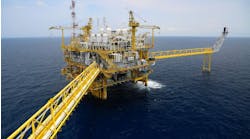As offshore reserves development continues to step out into increasingly deeper water around the world, conventional risers designed for floating production facilities, including flexible and steel catenary risers, become increasingly limited due to the need to increase diameter for collapse mitigation and to use more sophisticated metallurgy for higher overall heat transfer coefficient (OHTC), among other challenges.
Jean-Francois Saint-Marcoux, Jean New HRT system proposed
This paper discusses the challenges associated with ultra deepwater project development using hybrid riser tower (HRT) technology for floating production unit (FPU)-based field developments/layout.
As offshore reserves development continues to step out into increasingly deeper water around the world, conventional risers designed for floating production facilities, including flexible and steel catenary risers, become increasingly limited due to the need to increase diameter for collapse mitigation and to use more sophisticated metallurgy for higher overall heat transfer coefficient (OHTC), among other challenges.
In recent years, offshore operators have increasingly deployed HRTs for deepwater and ultra deepwater projects, particularly off West Africa and Brazil. The HRT has no limitations in terms of diameter, collapse, or OHTC. Additionally, an HRT limits the load on the FPU and can be located so as to ease implementation of future tiebacks.
HRTs promise to be a solution for ultra deepwater Gulf of Mexico field development, particularly as HRT design evolves to cope with the environmental conditions spawned by hurricanes and strong Gulf currents, and by the challenges of high-pressure, high-temperature petrophysical conditions native to the deepwater GoM operations.
A proposed new HRT riser system has been designed for deployment in the deepwater/ultra deepwater GoM, incorporating lessons learned from current HRT installations off Africa and Brazil. It is deemed suitable for all areas of the Gulf for the purpose of standardization.
The foundation for the system is suction piles, which are well-suited to GoM geotechnical conditions which are similar to those off West Africa. Installation is not water-depth sensitive and can be performed by service vessels.
With a suction anchor foundation, the seafloor hookup could be the Rotolatch-style connector with a flex-joint such as those being used on existing HRTs; however, the flex-joint would require routine qualification for ultra deepwater. A backup system, if necessary, could be a universal joint.
On West African installations, riser base gas lift has been the norm. This, however, has led to relatively complex arrangements at the bottom of the tower. In any case, GoM deepwater developments exhibit low GOR and the majority of deepwater risers rely instead on subsea boosting rather than gas lift. Also, connecting flow lines at the bottom of the HRT could be made with flanges using the Acergy MATIS system or with off-the-shelf connectors.
For single HRTs in the GoM, installation could be conducted either with J-lay or reel. For ultra deepwater, however, reeling system capacity may be limited, so J-lay may be the logical choice. For bundled HRTs, no heavy installation vessel is necessary, but buoyancy is required to balance the weight of the empty risers. In addition, either single or bundled HRTs must be qualified in terms of insulation and high-integrity pressure protection (HIPP), among other deepwater issues encountered in GoM waters.
Two options seem to be available for the top of the hybrid riser tower. They are:
- An integral buoyancy tank and taper joint going into the riser
- A separate buoyancy tank and a top-of-tower in which the flexible jumper connects to the riser.
Due to the powerful current in the upper layers of the Gulf, the buoyancy tank would be located at a deeper location – typically at about 700 ft (213 m) (compared to 250 ft [76 m] off West Africa). A diverless system is necessary for installing top jumpers. The flexible jumpers in the Gulf will be significantly longer than in West African waters (typically 2,000 ft vs. 800 ft [610 m vs. 244 m]). Specific jumper interference studies indicate it is possible to design the jumper to avoid the effects of both wake shielding and wake instability.
Conventional flexible jumpers have a high temperature limit -- to about 270°F (132°C). Those based on high-temperature polymer would be used for flowing temperatures above 300°F (149°C).
Choosing a single HRT or bundled HRTs depends on layout and cost-effectiveness. Bundled HRTs can accommodate a larger number of risers for a given layout due to the effect of wake interference between the risers themselves. However, when restricted to a few risers, single HRTs are an effective solution and do not require a fabrication yard.
The factors that affect installation of HRTs are:
- The weather window
- Fatigue of the HRT during the tow
- Risk associated with these operations.
The towing operation, though sometimes identified as an issue, has been conducted successfully five times in West African waters and always within the expected time allocated.
The GoM weather window is longer, thanks to the elaborate metocean monitoring systems in place both at the surface and subsurface. Additionally, the overall length of the GoM tow is shorter. And finally, he shorter waves of the GoM are less onerous in terms of fatigue, and the risk associated with the operations themselves are mitigated by the well-kept infrastructure and offshore services available in the GoM region.
The authors conclude:
- HRTs (single and bundled) are field proven
- They meet the unique challenge of load on the FPU, and flow assurance
- They have fewer limitations than SCR or flexible riser systems in terms of diameter
- Bundled HRTs offer an additional advantage in terms of layout.


